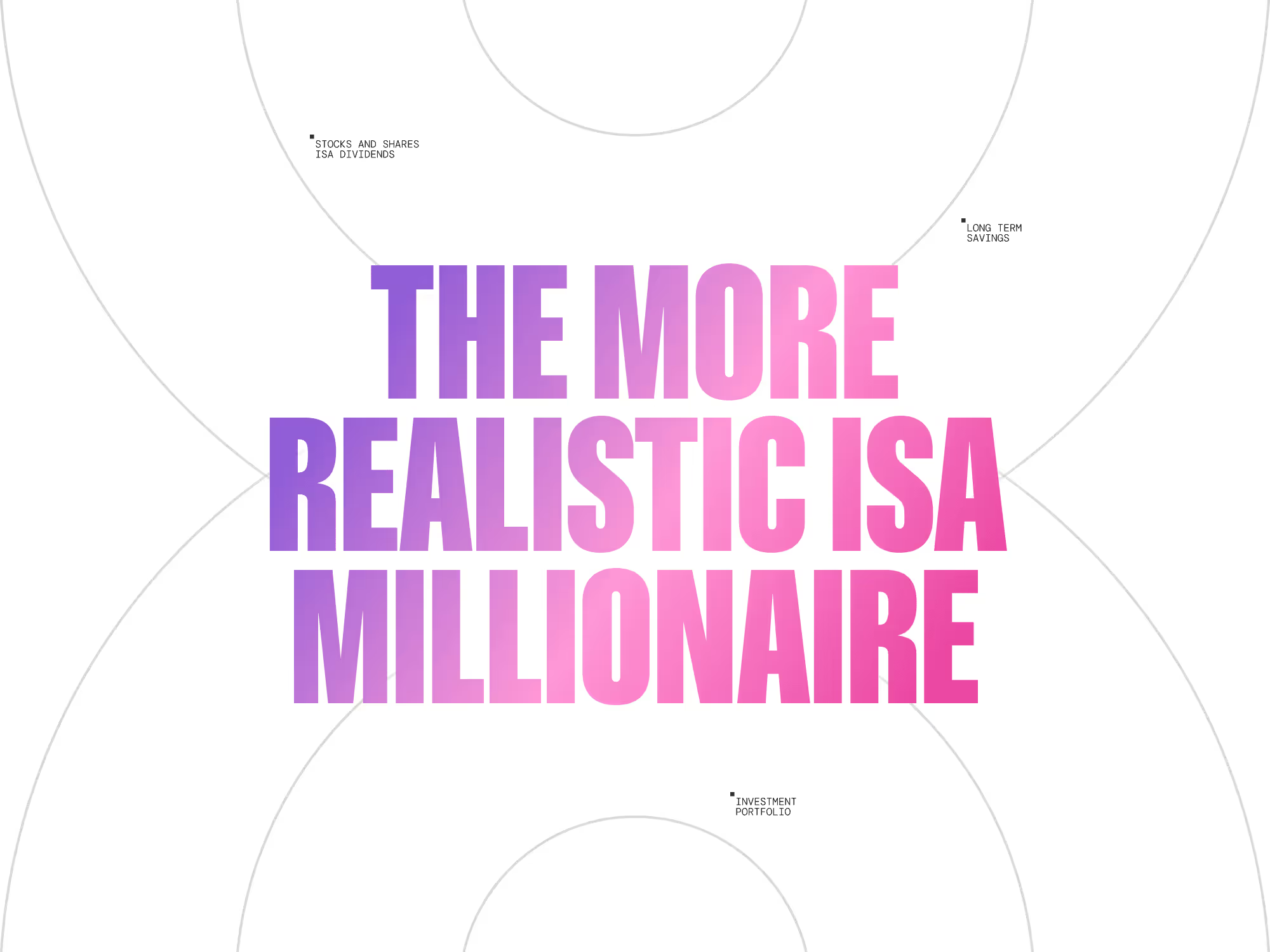It’s a funny number, £1m.
It holds so much cultural significance for us we made a TV show out of it.
Maybe that’s because it’s the smallest amount of money you need to be rich in our collective eyes. After all, it’s the first amount we add ‘-aire’ to. Thousandaires aren’t all that impressive in the UK, but an ISA millionaire, that’s a different story.
So maybe that’s why it stands as a financial goal for many people. A symbol of what hard work can get you and a level at which you can feel you’ve done well.
But what if you could get to the seven-figure sum, not by being a business tycoon or personal finance analyst, but by being a steady and ardent saver?
How to become an ISA millionaire
Normally when it comes to describing the maths to hit millionaire status in your Individual Savings Account (ISA), the eye-rolling starts.
The figures the financial industry trot out adopt some variant of “Just save the maximum £20,000 annual allowance into your tax-efficient ISA from the age of 18 and you’ll get there.”
Nauseating and perhaps even a bit insulting for the most part.
So, is it actually possible to become an ISA millionaire without generating crazy annual growth through investment returns or having huge wads of cash to start off with?
Yes and no, is the honest answer.
We’ve run the numbers and the maths stacks up but there are a lot of assumptions we have to make to get to the magical million.
We’ve put them below. You might think some are well within your grasp and others seem out of touch with what the average Briton could realistically earn or afford to put into their ISA.
And you’re probably right to scoff at certain aspects but the ISA maths doesn’t lie. Ultimately, it won’t be achievable for everyone because our earning potential and ability to save can swing wildly throughout our lives (and likely has done over lockdown).
Median annual earnings for full-time employees in the UK, 2015-2024
.avif)
But remember, that lovely round £1,000,000 figure is actually a fairly arbitrary number.
Using it as a goal works because we tend to see it as a significant milestone. But really the message to take away from all of this is how consistent investing and using time to compound quite a reasonable level of return can amplify your financial position.
That said, let’s look at the numbers. The salary figures below aren’t the most important part, as we’re looking at what you could invest, but we’ve used them to give an idea of how our potential savings rise as our earnings do too.
ISA millionaire investment strategy
- You start off earning £25,000 at 25 years old, investing £2,500 each year until you’re 30, achieving 5% returns, compounded once per year.
- At 30 you start to earn £30,000, just short of the national average. In your 30s you get yearly pay rises of 3%, just ahead of the Bank of England’s target inflation rate of 2%, and invest £5,000 each year.
- At 40, your pay goes up to £45,000. You keep getting yearly pay rises of 3% and put away £10,000 each year in your 40s.
- At 50, you start to earn £65,000, continue getting 3% pay rises and save £20,000 each year in your 50s.
- At 60, you start to earn £90,000 and receive 3% yearly pay rises until you retire at 65. You save £20,000 each year from 60 to 65.
- Taking into account a £4.99 monthly ISA fee, by retirement age, your total contributions of £461,060 have been able to snowball into a sum of £1,023,737.
Bear in mind that ISA fees can change over time too, they are not guaranteed. These results do not take account of inflation or charges.
Remember here that achieving a consistent 5% return for each and every year that you invest is not realistic. Whenever you invest, your capital is at risk. The value of your investments can go up as well as down and you may receive back less than your original investment.
But in the long run, stock markets tend to go up and if you take a long-term approach to investing, then the ebbs and flows in the short-term have a better chance of smoothing themselves out.
Putting your cash to work over the long term makes the most of the magic of compounding. Source: Freetrade, 2025.
Who wants to be an ISA millionaire? Well... everyone.
Initially, a few questions come to mind.
Where am I living during all of this? What about my pension, shouldn’t I be putting money into it too? How do I choose between an ISA and a SIPP (self-invested personal pension)?
Should I really be stock trading in line with those earnings at those ages?
And they are completely fair things to wonder.
A £90k salary would also put you among the country’s top earners, which won’t be where most of us end up. But the figures at the lower end might actually look quite reasonable, using the UK’s average earnings figures as a yardstick.
So possible, yes. Probable, less so. That doesn’t mean it can’t remain a goal. And maybe seeing it written down in black and white can serve as a bit of scaffolding.
It might help you structure how you think about hitting your financial goals, no matter how many zeros they have on the end of them.
The focus should really be the bigger picture here. Just look at what a consistent approach to investing over the long term, and letting time do the work, can achieve.
If you’re able to start earlier, or save more than £208.33 per month in your 20s, or £416.67 in your 30s it can really shave off the sums you’d have to save later down the line. That’s thanks to the time you’ll have on hand to compound your money.
Stocks and shares ISA dividends
So while we’re talking compounding, let’s talk dividends.
They’re the bedrock of all long-term stock market investing and, if you’re aiming to become an ISA millionaire, they’ll likely be a key part of your journey.
So, let’s start with “what is a dividend?”
It’s a regular payout from a company to its shareholders as a thank you for being there, and also to keep investors sweet and invested.
The payment amount depends on the earnings that company makes.
So, rather than getting doe-eyed at headline dividend percentages, we need to make sure those earnings are strong and consistent enough to keep our dividends flowing.
In short, a company’s ability to pay a dividend matters more than the dividend itself.
Start by looking past the top line figure, to the dividend cover.
Is the firm actually going to be able to pay you that figure, and sustainably, or are you being hypnotised by the big number when the rest of the business is collapsing?
With a lot of dividends starting to reappear after hibernating during lockdown, it's also important to keep tabs on a company's share price.
Income payments might resume but if the share price stumbles across the bottom of the page it's not going to make your portfolio any happier.
Back to dividend cover. You'll likely see it expressed as holding ‘2x’ or ‘3x’ the level needed to meet the next dividend.
Another figure to watch out for is the dividend yield. This is calculated by dividing a stock’s total annual dividends per share by its share price. It shows you the return you’d earn from an investment if it were solely dividend payments, as opposed to potential capital gains or losses too. Dividend yields are one of many stock fundamentals now available with Freetrade’s Standard and Plus plans.
To sort the leaders from the masses, you may want to take a look at the levels of cash on a firm’s balance sheet. Because quite often, the top dividend stocks of the moment can no longer keep up with those payments, and they stop being so good after their 15 seconds of fame.
That 5% return we’re aiming for can be made up of growing dividends and a rising share price. So remember to factor both into your strategy.
Why should I use my ISA for income?
Something the growth side of the ISA millionaire story can miss is the benefit of using an ISA after the accumulation phase is complete - whether you’ve hit the £1m mark or not.
We normally associate taking an income from our investments with retirement, and tapping into that pension pot.
Long-term savings are clearly geared towards letting you do just that. Currently you can’t access your pension until you’re 55, and that will increase to 57 by 2028. Though, if you’re planning to take an income from your investments then you don’t have to be confined to your retirement savings.
Using an ISA has the benefit of not requiring you to pay tax when you take your money out of it - something you have to consider when you take money from your pension later in life.
Of course there are things like company contributions and tax relief you get with a pension so they’re definitely not to be overlooked.
But what if your plan is to wind down in work before the age of 55, or before the state pension kicks in around the age of 68?
You might have plans to go part-time or just take on the projects you want. Income from your ISA could help supplement your pay until you can access your pension savings.
So, given that growing those dividends and aiming for that 5% compound growth (or higher) is the goal, what assets are out there to help?
ISA millionaire investment portfolio
It’s up to you what to put in your investment portfolio but there are US and UK stocks, and investment trusts (aka investment companies), with a strong commitment to growing their dividends as well as aiming for capital growth at the same time.
The long-term average dividend yield of the UK stock market sits at around 4-5%. If you find consistency around or above that level (and not so high that you’re left wondering how sustainable that yield could really possibly be), then you’re on the right track.
Remember, investment returns, and annual growth in general, should be a blend of capital growth and income. A balanced portfolio will have elements of both, so that your investment goals don’t depend on just one corporate strategy or dividend policy.
That means you’ll probably end up with a range of sectors and geographies naturally.
Popular stocks in the UK might be some blue chip companies in the consumer staples sector, big pharma and even the likes of British American Tobacco (BAT) or Shell (the artist formerly known as Royal Dutch Shell). These aren’t recommendations, just a few firms aiming to grow revenues and keep dividend-hunters happy.
You can also have a look at the so-called dividend aristocrats who prize maintaining their dividends over almost everything.
As always though, nothing is guaranteed and the pandemic period has demonstrated that well. The regulator asked UK banks to stop paying dividends and keep that cash in case the nation’s borrowers couldn’t pay back their loans and mortgages.
Companies across the board chose to bolster their own cash piles too, in lieu of paying dividends. The important element here is that we need to understand the variability of dividend payments and remember that a firm chopping its own payout down isn’t just theory - it very much can be a reality.
Here’s one we made earlier…
Thankfully, there are exchange-traded funds (ETFs) that keep tabs on dividend-paying stocks for you.
Examples here include the SPDR S&P US Dividend Aristocrats ETF, which tracks the 60 highest-yielding US stocks with 25 consecutive years of growing dividends, and the SPDR S&P UK Dividend Aristocrats ETF, which follows the performance of the best UK dividend stocks.
Have a look at the investment trusts in the dividend hero brigade too. These are investment companies with fund managers at the helm, searching the globe for growth and income opportunities.
A key highlight of investment trusts is their ability to put 15% of their income to one side each year, so they can bolster payments to investors when dividend income suddenly becomes hard to find.
They also have access to private equity and can invest in companies long before they come to the stock market.
Collective investments like these can be useful as a readymade basket of diversified income sources. But make sure you actually look at the fund’s investment objectives, how the fund manager likes to invest and the fund holdings.
If you hold a few of them you might end up holding the same company across various funds. ‘Dividend clumping’, as it’s known, actually concentrates your money over just a few individual equities instead of giving you the well-diversified portfolio you’re aiming for.
You might even want to think about looking beyond the obvious dividend-paying diversified trusts and income stocks to the alternative sources of income on the stock market, for diversification.
It’s important to say that simply investing in these assets isn’t a passport to the ISA millionaire club. There’s risk involved in all types of investing, and whether you’ve got a collection of stocks, ETFs or diversified investment trusts, outcomes are never guaranteed.
Before you get into any of it, have a look at our guide on how to trade stocks for beginners.
What is an ISA?
If all of this intrigues you and you haven’t quite got to grips with ISAs just yet, here’s a quick guide.
An ISA is an account you can use to put money away and, with a Stocks and Shares ISA, invest it for your future.
It’s not the only type of ISA around though. You might have seen ads for a cash ISA in your high street bank too. As its name suggests, you can only put cash in there - meaning you won’t be able to add any company shares to your account.
That can be attractive for people who just don’t want to take the risk associated with the stock market.
After more than a decade of interest rates sitting at record lows, the last four years have seen a shift. The Bank of England has steadily increased interest rates, peaking at 5.25% in August 2023. However, this wasn’t necessarily a win for cash savers. Inflation far outstripped interest rates until October 2023, meaning their cash was eroding in real terms. The Bank Rate then decreased to 5.00% in August 2024, and currently stands at 4.50% as of February 2025.
.avif)
.avif)
October 2023’s drop in inflation brought good news to cash savers - their cash stopped eroding in value thanks to CPI dipping to 4.6% whilst interest rates remained at 5.25%.
So, why invest when cash savings are generating returns?
Keeping some cash in a savings account is important as it gives you easy access for those ‘rainy day’ moments. Cash is safe, but the trade off is that you haven’t taken any investment risk so you might not gain as much as you would in a long-term well-diversified Stocks and Shares ISA, but you might not lose as much either.
Investing is for the long-term (think five years or more) and historically has been a better way to grow your wealth because the stock market can generate returns that outstrip the risk-free rate and inflation.
Take the S&P 500 for example. This market-capitalisation weighted index of the 500 leading publicly traded companies in the US has returned a historic annualised average return of over 10% since its inception in 1957. That’s double the return of the average easy access cash ISA at the moment. Bear in mind that past performance is not a reliable indicator of future returns.
Discrete calendar year performance
Source: Yahoo Finance, as of 18 February 2025
As of February 2025, the Bank of England has reduced the Bank Rate to 4.5%, following a 0.25 percentage point cut. This decision reflects progress in reducing inflationary pressures within the UK economy. However, the Bank anticipates that inflation will temporarily rise to around 3.7% in the third quarter of 2025, primarily due to higher global energy costs and regulated price changes, before returning to the 2% target thereafter. The Monetary Policy Committee has indicated that while further reductions in the Bank Rate may be possible as disinflation continues, any such decisions will be approached cautiously, considering ongoing uncertainties in both domestic and global economic conditions.
Investing is also a way to diversify your wealth. Cash is one type of asset, but you can diversify into stocks, ETFs, investment trusts, and Treasury bills, too. You can invest in different geographic regions, like the UK, US, Europe, APAC and LATAM, and different industries. These different assets have different levels of risk, and consequently, potentially bigger returns.
You can contribute up to £20,000 during the 2025/26 tax year (from April to April).
You could opt for an annual contribution at the start or end of the tax year or make regular contributions after payday each month. Ad-hoc contributions are fine too if you get a bit of birthday money to put towards your investment goals.
You can put money in and take it out when you need to but it’s important to remember that if you’re investing you should take a long-term view.
A key thing to understand from the get-go is that the ISA is just the outer shell for you to fill with your investments - it’s not an investment itself.
That’s why you’ll often hear it described as a ‘wrapper’ - you get to decide on the filling.
And the reason you’ll also hear that one-upped to ‘tax wrapper’ is because, when you put your investments in an ISA, you don’t have to pay tax on any capital gains your investments might achieve.
Read more:
Top 10 ISA stocks and shares at Freetrade
Stocks and shares ISA allowance
Stocks and shares ISA rules
When you invest, your capital is at risk. The value of your investments can go down as well as up and you may get back less than you invest.
Freetrade does not give investment advice and you are responsible for making your own investment decisions. If you are unsure about what is right for you, you should seek independent advice.ISA and SIPP eligibility rules apply. Tax treatment depends on personal circumstances and current rules may change.
Check before you transfer that we can accept your investments, you won’t lose any guarantees, and that you know what charges you may incur.
A SIPP is a pension designed for you to save until your retirement and is for people who want to make their own investment decisions. You can normally only draw your pension from age 55 (57 from 2028), except in special circumstances.
At present, Freetrade only supports Uncrystallised Fund Pension Lump Sums (UFPLS) for customers who wish to withdraw funds from their SIPP after their 55th birthday. We strongly encourage you to seek financial advice before making any withdrawals from your SIPP.












